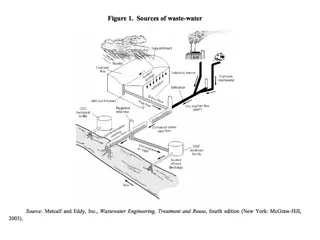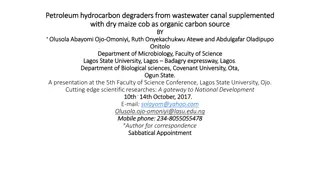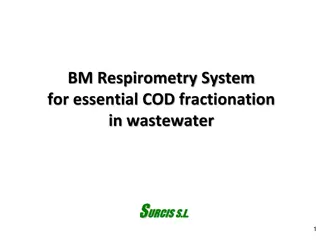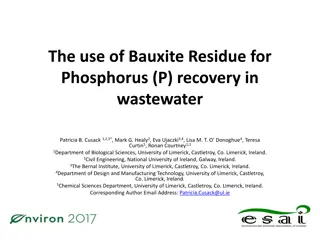The Perspective of Wastewater Management by Dr. Homero Silva
Dr. Homero Silva, a Professor in Public Health, discusses the importance of wastewater management in addressing environmental issues. The content covers topics such as real values of Jamaican BOD5, total nitrogen values, and the significance of effective treatment methods. Insights into typical domestic sewage characteristics and confidence intervals for various parameters are also provided. The discussion highlights the need for sustainable practices and understanding the impact of wastewater discharge on natural water bodies.
Download Presentation

Please find below an Image/Link to download the presentation.
The content on the website is provided AS IS for your information and personal use only. It may not be sold, licensed, or shared on other websites without obtaining consent from the author.If you encounter any issues during the download, it is possible that the publisher has removed the file from their server.
You are allowed to download the files provided on this website for personal or commercial use, subject to the condition that they are used lawfully. All files are the property of their respective owners.
The content on the website is provided AS IS for your information and personal use only. It may not be sold, licensed, or shared on other websites without obtaining consent from the author.
E N D
Presentation Transcript
The Perspective of Wastewater Management Dr. Homero Silva Professor in Public Health, Environment and Climate Change School of Public Health and Health Technology UTECH
We live in an environmental arrogance Because of our Environmental ignorance due to our environmental tolerance
Real values Jamaican BOD5 Real BOD5 Effective Treatment Treatment based in Epidemiological Context
BOD5with outliers 95% Confidence interval (199 mg/l, 233 mg/l)
BOD5 without outliers 95% Confidence interval (194mg/l ,226 mg/l)
Total Nitrogen with outliers 95% Confidence interval (37.1 mg/l, 43.8 mg/l)
Total Nitrogen without outliers 95% Confidence interval (35.4 mg/l, 40.6 mg/l)
Jamaica Total BOD5 Values Without Outliers With Outliers 283 209,70 8,147 172,80 103 137,052 Number of Samples Mean Std. Error of Mean Median Mode Std. Deviation 285 213,79 8,589 173,70 103 145,003 Variance 21025,917 18783,119 Skewness Std. Error of Skewness Kurtosis ,959 ,695 ,144 ,145 ,773 -,471
Jamaica Total Nitrogen Values Without Outliers 275 With Outliers 275 Number of Samples Mean 40,479 38,025 Std. Error of Mean 1,7113 1,3134 Median 36,700 36,400 Mode 52,8 52,8 Std. Deviation 28,6357 21,7805 Variance 820,006 474,389 Skewness 2,404 ,649 Std. Error of Skewness ,146 ,147 Kurtosis 10,738 ,210
The Real BOD5 The test was developed around 1910 in England, To predict the oxygen sag when sewage is discharged into the river and how long it would take the river to self purify . Oxygen sag is the lowering of dissolved oxygen in the river over a certain distance, downstreamsof the discharge of sewage and self purification is achieved when the dissolved oxygen level is again the same, as it was before the sewage was discharged in the river.
The BOD test measures how much oxygen is used by bacteria, until all such activity cedes. it is the summation of two oxygen usages, one of heterotrophic bacteria feeding on carbonaceous (fecal) waste or C-BOD and the second one that of autotrophic bacteria feeding on nitrogenous (urine and protein) waste or N-BOD.
Autotrophic bacteria only contributes to the test reading after 6 to 8 days The use of oxygen by autotrophic bacteria can be calculated by using the faster TKN (Total Kjeldahl Nitrogen) test, it became common, in order to save time, to use the 5- day reading of the test (BOD5), representing part of the oxygen use by the heterotrophic bacteria, in combination with the TKN test representing the oxygen used by the autotrophic bacteria.
Real Total BOD Total BOD= C-BOD (1.5 x BOD5) + N- BOD (4.6 x TKN). Total BOD= 1.5 x 210 + 4.6 x 38 Total BOD= 497.4
Effective Treatment Are discharge standard limits sufficient to protect health?
Effective Treatment BOD5 vs Heavy metals and Endocrine disruptors
Treatment based in Epidemiological Context
Epidemiological-Demographic and Socio-economic transitions Top five leading causes of death in Jamaica 1945-2004 1945 1982 1996 2004 Cerebrovascular Disease Cerebrovascular Disease Cerebrovascular Disease Tuberculosis Heart Disease Heart Disease Diabetes Mellitus Diabetes Mellitus Malignant Neoplasm Ischaemic Heart Disease Nephritis Ischemic Heart Disease Hypertensive Diseases Syphilis Hypertension Hypertensive Diseases Pneumonia Diabetes Mellitus Homicide/Assault Other Heart Disease Influenza Accidents and Injuries- (Accidents, poisoning and violence)* Gastroenteritis 21 Source: Chronic Disease in the Caribbean: Jamaica Case Study
Epidemiological-Demographic and Socio-economic transitions Top five leading causes of death in Jamaica 1945-2004 1945 1982 1996 2004 Cerebrovascular Disease Cerebrovascular Disease Cerebrovascular Disease Tuberculosis Heart Disease Heart Disease Diabetes Mellitus Diabetes Mellitus Malignant Neoplasm Ischaemic Heart Disease Nephritis Ischemic Heart Disease Obesity Hypertensive Diseases Syphilis Hypertension Hypertensive Diseases Pneumonia Diabetes Mellitus Homicide/Assault Other Heart Disease Influenza Accidents and Injuries- (Accidents, poisoning and violence)* Gastroenteritis 22 Source: Chronic Disease in the Caribbean: Jamaica Case Study
Present Health Conditions and Threats Chronic Diseases Obesity Mental Health Violence Sedentarism Junk Food Energy Consumption per capita Environmental Pollution
Estimated DALYs per 100,000 population, 2004 Jamaica Communicable, maternal, perinatal and nutritional conditions 3,893 NCDs 10,250 Injuries 2,170 Total 16,314
Country profile of Environmental Burden of Disease (Jamaica)
DALYs Comparison for Total Jamaica Population NCDs Diarrheas 10,250 Years Lost 280 Years Lost Where we need to look at in Environmental Health?
Attention Deficit Hyperactivity Disorder (ADHD) in Jamaican Children 12% of 5-6 yr olds with externalising behaviour disorders (Samms-Vughan, 2005); None of the Children had received assistance Prevalence likely to be higher in inner-city areas Jamaican and Thailand Children highest rate ADHD in the world (Achenbach, 2007)
Manganese and Anemia Excess manganese interferes with the absorption of dietary iron. Long-term exposure to excess levels may result in iron-deficiency anemia. Excess manganese may be a problem for infants with low iron status, as this is known to increase the absorption of manganese. Mena et al. (1969) found that anemic subjects absorbed 7.5% of ingested Mn, whereas normal subjects absorbed 3%. IDA patients had a mean blood Mn concentration of 2.05 0.44 g/dl, which was higher than controls. (Kim 2005) Calcium deficiency increases manganese absorption (See Bottled Water Slide).
Nitrates in Drinking Water and health Diabetes incidence was positively associated with raised mean nitrate levels with a standardized incidence ratio of 115 in zones with greater than 14.85 mg.1-1 (chi2 = 26.81, 1 df, p < 0.001). (Parslow, 1997) A research in United States suggested a positive correlation between low- level nitrate exposure through drinking water and type 1 diabetes at nitrate levels < 10 mg/L (Kostraba, 1992). Nitrite may also react in the stomach with amines and amides to form N- nitroso compounds, which have genotoxic properties (van Maanen, 1992; Vermeer, 1998) and may also play a causative role in the initiation of gastric cancer (Gangolli, 1994). A role of N-nitroso compounds in the etiology of cancer of the esophagus and nasopharynx (Magee, 1989) as well as a linkage between the occurrence of non-Hodgkin lymphoma and nitrate exposure have been suggested (Ward, 1995). New targets for nitrate exposure were recently defined, including thyroid and pancreas. Nitrate exposure can lead to hypertrophy of the thyroid due to inhibition of uptake of iodine by the thyroid (Van Maanen, 1994) Germans found this effect at 22.5 mg/l Nitrate as NO3. (Horing, 1988)
Nitrates in Drinking Water and health From the above information the NWC wells in the metropolitan area should be evaluated, specially those that are above 22.5 mg/l as NO3 . Table below presents information on Nitrate concentration of some of the wells. Table 1. Major anions in the well waters of the Kingston Basin. Cl- 234 30 82 NO3- 5.2 20.5 24.9 HCO-3 301 357 240 Well Name Rockfort Devon House Forrest Hills NO3- as N 1.17 4.63 5.62 SO4 76 62 27 Chancery Hall 23 23.4 5.29 255 22.7 Havendale 22 4.7 1.06 245 20 Cavaliers 52 15.3 3.46 259 76 Up Park Camp 43 48.5 10.96 258 87.2 Montgomery Corner 13 56.6 12.79 96.4 59.6 Rennock Lodge 176 20.2 4.56 218 105 Beverly Hills 17.2 5.6 1.27 111 104 Forest Hills, Beverly Hills, Montgomery Corner, Cavaliers, and Up Park Camp are not being Used by NWC, because of high NO3
Endocrine Disruptors and Obesity Diet and physical activity are undoubtedly key causal factors related to the increase in obesity. There is growing interest in the possibility that endocrine disrupting chemicals (EDCs) may affect obesity-related pathways by altering cell signaling involved in weight and lipid homeostasis* The idea that changes in the diet and physical activity cannot account for all of the increase in obesity is strengthened by evidence showing that most energy expenditure is devoted to basal metabolism and other physiological processes. * Homeostasis is the property of a system in which variables are regulated so that internal conditions remain stable and relatively constant.
Perturbation of Thyroid Function Thyroid function is key to maintenance of basal metabolism. A number of EDCs, including phthalates, BPA, and PBDEs, are suspected thyroid disruptors and seem to have the net effect of reducing circulating thyroid levels (Zoeller, 2007). While much early work on endocrine disruption focused on reproductive and carcinogenic effects, the hypothesis that chemicals may affect weight homeostasisemerged more recently from different lines of research.
Leptin Hormone Where adipose tissue was once considered an inert storage depot, the discovery of the hormone leptin in the 1990s led to the recognition that adipose itself is an active endocrine organ, secreting various hormones and adipokines and expressing many receptors (Ahima and Flier, 2000; Newbold, 2009). Evidence was also mounting in support of the concept of the developmental basis of adult disease, which suggests that exposures in utero could lead to chronic diseases later in life (Heindel, 2003; Oken and Gillman, 2003).
In utero exposures It may be particularly important due to sensitivity during development. Certain environmental agents or stressors during critical windows of development can lead to obesity later in life. The thrifty phenotype hypothesis postulates that an undernourished fetal environment causes permanent metabolic programming aimed at conserving nutrients, leaving the individual susceptible to obesity and other metabolic disorders when faced with the unrestricted diet typical of many developed countries (Gluckman, 2008). This programming likely involves epigenetic alterations in the methylation patterns and histone structure that help determine gene expression, alterations which may lead to obesity due to permanent changes in the function of specific tissues (Heindel and vom Saal, 2009). Maternal malnutrition, smoking, diabetes, and chronic stress have all been consistently associated with childhood obesity in epidemiologic studies, and provide evidence for this phenomenon (Huang, 2007).
In utero exposures The average newborn has 287 chemicals in the umbilical cord blood, 217 of which are neurotoxic. The chemicals these infants are exposed to include pesticides, phthalates, bisphenol A, flame retardants, and heavy metals such as mercury, lead, and arsenic. 20% of POPs are transferred to the fetus Breastfeeding releases 8.76 kg fat per year A breast fed baby receives 10% of the cumulative dosage of a 50 years person Dioxine concentration of a baby is 1.7 times the mother concentration
PCB, HCB and DDE Serum Concentrations Breast Fed versus Formula milk 6 weeks y 6 months 2.5 Breast Fed 6 weeks 2 Breast Fed 6 months Serum Concentration, /l Formula Milk 6 wweks Formula Milk 6 months 1.5 1 0.5 0 PCB 138 PCB 153 PCB 180 Pollutant Type Sigma PCB HCB A DDE, A
A "striking" relationship: POPs and diabetes A 2006 study found "striking" relationships between six POPs and diabetes in U.S. adults exposed to normal levels of POPs. The higher the levels of these POPs, the higher the prevalence of diabetes. In the highest exposure group, the risk of diabetes was 37.7 times higher than in the people with the lowest levels of exposure. Surprisingly, this study found that obesity did not increase the risk of type 2 diabetes if those people had very low levels of POPs in their bodies.
Treatment based in Epidemiological Context Increase in water reuse for green areas irrigation Milking wastewater from sewage Removing bacteria and Endocrine disruptors and leave nutrients























